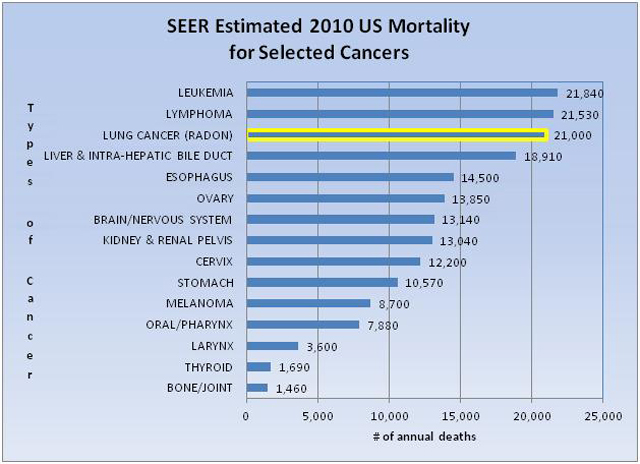xposure to Radon Causes Lung Cancer In Non-smokers and Smokers Alike
The Facts…
- Lung cancer kills thousands of Americans every year. Smoking, radon, and secondhand smoke are the leading causes of lung cancer. Although lung cancer can be treated, the survival rate is one of the lowest for those with cancer. From the time of diagnosis, between 11 and 15 percent of those afflicted will live beyond five years, depending upon demographic factors. In many cases lung cancer can be prevented.
- Smoking is the leading cause of lung cancer. Smoking causes an estimated 160,000* cancer deaths in the U.S. every year (American Cancer Society, 2004). And the rate among women is rising. On January 11, 1964, Dr. Luther L. Terry, then U.S. Surgeon General, issued the first warning on the link between smoking and lung cancer. Lung cancer now surpasses breast cancer as the number one cause of death among women. A smoker who is also exposed to radon has a much higher risk of lung cancer.
- Radon is the number one cause of lung cancer among non-smokers, according to EPA estimates. Overall, radon is the second leading cause of lung cancer. Radon is responsible for about 21,000 lung cancer deaths every year. About 2,900 of these deaths occur among people who have never smoked. On January 13, 2005, Dr. Richard H. Carmona, the U.S. Surgeon General, issued a national health advisory on radon. Read a study by Dr. William Field on radon-related lung cancer in women at www.cheec.uiowa.edu/misc/radon.html
- Secondhand smoke is the third leading cause of lung cancer and responsible for an estimated 3,000 lung cancer deaths every year. Smoking affects non-smokers by exposing them to secondhand smoke. Exposure to secondhand smoke can have serious consequences for children’s health, including asthma attacks, affecting the respiratory tract (bronchitis, pneumonia), and may cause ear infections.
Studies Find Direct Evidence Linking Radon in Homes to Lung Cancer
(2005) Two studies show definitive evidence of an association between residential radon exposure and lung cancer. Two studies, a North American study and a European study, both combined data from several previous residential studies. These two studies go a step beyond earlier findings. They confirm the radon health risks predicted by occupational studies of underground miner’s who breathed radon for a period of years. Early in the debate about radon-related risks, some researchers questioned whether occupational studies could be used to calculate risks from exposure to radon in the home environment. “These findings effectively end any doubts about the risks to Americans of having radon in their homes,” said Tom Kelly, Former Director of EPA’s Indoor Environments Division. “We know that radon is a carcinogen. This research confirms that breathing low levels of radon can lead to lung cancer.”
- Abstract of the pooling of North American Residential Radon studies (PDF)(2 pp., 22 K, About PDF).
- Abstract of the pooling of the European Residential Radon studies (PDF) (1 page, 26 K).
Radon-related Lung Cancer Deaths Compared to Other Select Cancers
The following graphic compares EPA estimates of the annual radon-related lung cancer deaths to other selected cancers. The other mortality numbers in this graphic were obtained from the National Cancer Institute’s 2010 Surveillance, Epidemiology, and End Results (SEER) estimated US mortality numbers which can be found at http://seer.cancer.gov/csr/1975_2007/results_single/sect_01_table.01.pdf
Information obtained from the EPA


